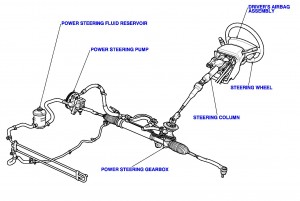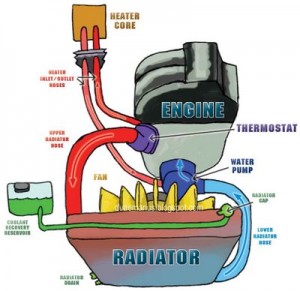Vehicles have different fluids that go with the components and systems in which they came equipped. All of these fluids perform a a different job but they all have one thing in common: When they break down chemically, they are less able to do their job and that’s when damage to the components occurs. Let’s take a look at these fluid and why it is important to replace them periodically.
Brake Fluid
This is a hydraulic fluid that allows pressure to be created in the brake system allowing your brakes to function. If a vehicle has brakes, it has brake fluid. There are however, (2) faults that brake fluid has:
- Brake fluid is hygroscopic – That means it absorbs water. The higher the water content of your brake fluid reduces its boiling point. This can lead to brake failure if the brake system is unable to create sufficient hydraulic pressure due to brake fluid that is turning from liquid to gas.
- Contamination – The rubber parts on the interior of the brake system such as the insides of the hoses, deteriorate over time and the brake fluid becomes contaminated with dirt and silt. This dirty fluid can cause problems later down the road with your ABS system.
Most vehicle manufacturers recommend brake fluid replacement every 30,000 – 60,000 miles. At Padonia Auto Service, we have the tools to provide a full, 100% brake fluid replacement properly and efficiently.
Power Steering
The power steering pump pumps its fluid at extremely high pressure down to the steering rack or gearbox to decrease the effort needed to steer your vehicle. Your power steering fluid has a tendency to get dirty very easily due to how it is utilized. Dirty, broken down fluid in the power steering system will increase the wear on the steering pump and can cause other components such as the rack and pinion to develop leaks. Here’s a diagram of a typical power steering system in a car.

Antifreeze
Antifreeze is a very important fluid that most modern vehicles have. The terms “Antifreeze” and “Coolant” are used interchangeably. They both refer to the Ethylene-glycol chemical which is combined with water -normally to a 50/50 mixture- and circulates through the engine, radiator and heater core. Antifreeze has a few distinct purposes:
- Antifreeze is combined with water to keep the water from freezing in sub freezing temperatures like those of Maryland during the winter months.
- The antifreeze/water combo is also used to take heat from the engine, pass it through the radiator which in turn cools it, then return to the engine. This is made possible by the water pump and is to prevent overheating of the engine.
- The fluid is also where the heat in your vehicle comes from. Not only does it pass through the radiator but also through what is called a “heater core” which is basically a very small radiator inside your dashboard. Air is passed over this before it enters the cabin.
Below (left) is a diagram of a typical cooling system:

When antifreeze breaks down, it easily clogs important passageways. This leads to previously unnecessary repairs. The picture below (right) shows the top of a radiator and the passages that have begun clogging with broken down antifreeze. If your radiator looks like this, now is the time to flush out the old fluid and replace with new.
Automatic Transmission Fluid
If your vehicle is equipped with an automatic transmission, it relies on this fluid in order to function and move. Automatic transmission fluid is a red/pink color when it is new on most vehicles. The exception being vehicles with a Continuously Variable Transmission or (CVT). The fluid used in these transmissions is generally a brownish color. Because when automatic transmission fluid becomes this brownish color when it begins breaking down, it can be easily confused. There are hundreds of tiny passageways in an automatic transmission in which its fluid must travel through. Not only that, but there are also springs, ball bearings, electrical switches, wiring and relays; all of which can become a problem with dirty fluid. If your automatic transmission fluid has become brown or even black, its time to be replaced. At Padonia Auto Service, we have state of the art equipment which pumps out all of your vehicle’s transmission fluid and replaces it with brand new, red, fully synthetic automatic transmission fluid. Think of it as a total fluid transfusion. Below (right) is a chart to give you a general idea of the colors we are talking about when it comes to automatic transmission fluid.

Manual Transmission / Differential / Transfer Case
The remaining three items we will talk about generally take a lubricating oil rather than a hydraulic fluid. Also, its important to mention that because these items don’t have a pump and are strictly gear boxes, the oil inside is not under any pressure and due to this, tends to last a fairly long time. One of the reasons for this is because in one of these gear boxes, generally the fluid becomes contaminated from metal shavings which come from the gears wearing down. That’s why they come with magnetic drain plugs, to hold most of these shavings and keep them out of the fluid, sort of like a filter.
- Manual Transmission – If your vehicle is a stick shift, its equipped with one of these instead of an automatic
- Differential – This is a gear box that distributes torque left and right. The differential can be observed as the large round part of a front or rear axle on most 4×4 vehicles. Rear wheel drive vehicles will have these as well but most other vehicles have an integral differential which is inside the transmission.
- Transfer Case – This is a gear box on 4-wheel drive vehicles that transfers power to the front wheels to engage 4×4 mode for maximum traction
Fluid replacement should be taken seriously
Its a maintenance item of every single vehicle and it can -without any doubt- prevent unnecessary future repair bills. At Padonia Auto Service, we check all fluids every time we service a vehicle. If you can’t remember when the last time you had any of the fluids serviced on your vehicle, its time to make an appointment.



 We employ ASE Certified technicians, the industry standard for automotive repair certifications. Only the most committed technicians will test and become certified.
We employ ASE Certified technicians, the industry standard for automotive repair certifications. Only the most committed technicians will test and become certified.

